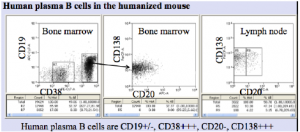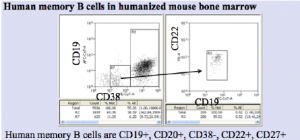German Cuadra and Dr. Bradford Berges, Microbiology & Molecular Biology Department
Our study focuses on the development of an animal model capable of reproduce cellular responses as in humans. For years humanized mice have been used in the study of infectious diseases. The goal of this research was to document, characterize and record the existence of human B cell lineage and penetration into different tissues of humanized mice.
Human B cells are the primary targets of infection for many viruses that are poorly understood and thus the necessity of characterization of these cells for appropriate research of human adaptive immunity – humoral immunity- using an animal model.
In order to better understand the kinetics of B cell differentiation and migration we sacrificed used humanized mice from Dr. Berges’ laboratory. These mice were previously transplanted with human hematopoietic stem cells leading to the development and production of human blood cell types and an immune system as in humans in the mice.
We sacrificed humanized mice and perform FACS analysis using labeled specific human B cells every three weeks after engraftment and one non-humanized mice as control for the experiment.
For over 20 weeks we gathered information of the differentiation and migration of B cells. The tissues used for data collection were bone marrow, thymus, spleen and lymph nodes. We also saved and froze tissue for further immunohistological analysis.
Our gathered data on this project is represented on the following graphs showing that various types of human B cells are detected in lymphoid organs of humanized mice.
We found that Human CD138+ plasma B cells were readily detected in the bone marrow of humanized mice. The phenotype of these cells matched up well with published plasma cell phenotypes with the exception that the CD138 stain was weaker than expected. Memory B cells (CD22+ and/or CD27+) were readily detected in the bone marrow and blood of humanized mice. These cells were CD38-, in accordance with expected results
We were able to present our results in the ASM 2012 Intermountain Branch Meeting at Idaho State University.
So far we have concluded that Rag2–/–γc–/– mice engrafted with human hematopoietic stem cells produce human B cells. These cells are detectable in the blood, spleen, bone marrow, lymph nodes, and thymus.
Also that Human CD138+ plasma B cells are detectable in the bone marrow and lymph nodes. And that Human CD22+ and/or CD27+ memory B cells are detectable in the blood and bone marrow.
We are currently working on this project analyzing new data and progressing towards a publication on this study. We hope that this project will help to establish a great spectrum of data that would potentially improve the usage and application on the study of infectious diseases in humanized mice. All the information gathered on this study will be needed and used for future studies of human humoral immunity in humanized mice. Once the correct linages of cells are established, in our animal model, most accurate experimental design would be available to scientists.




